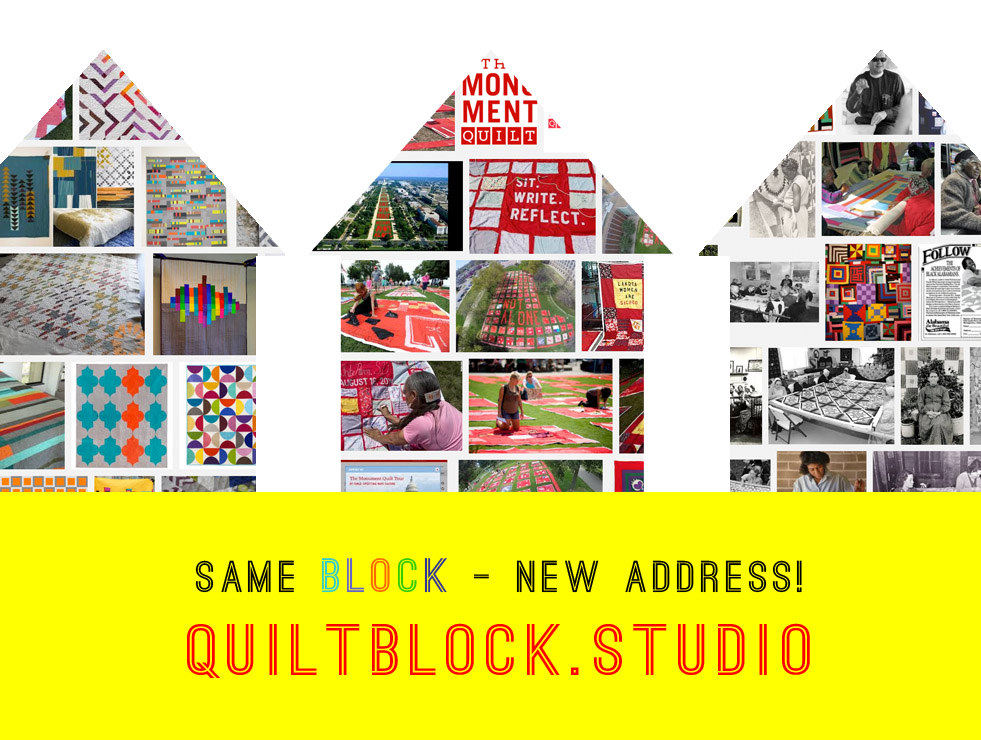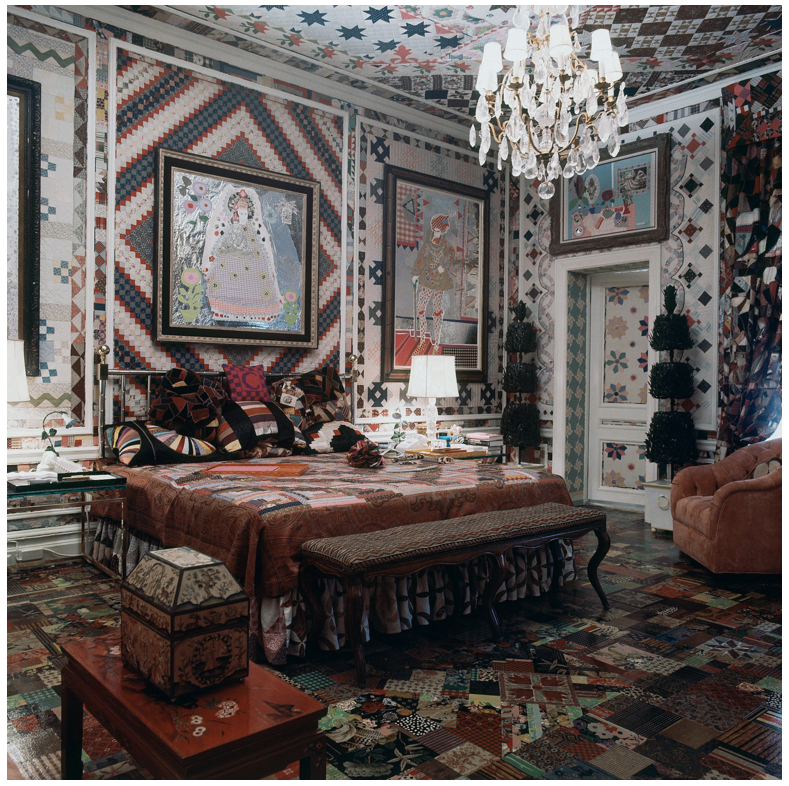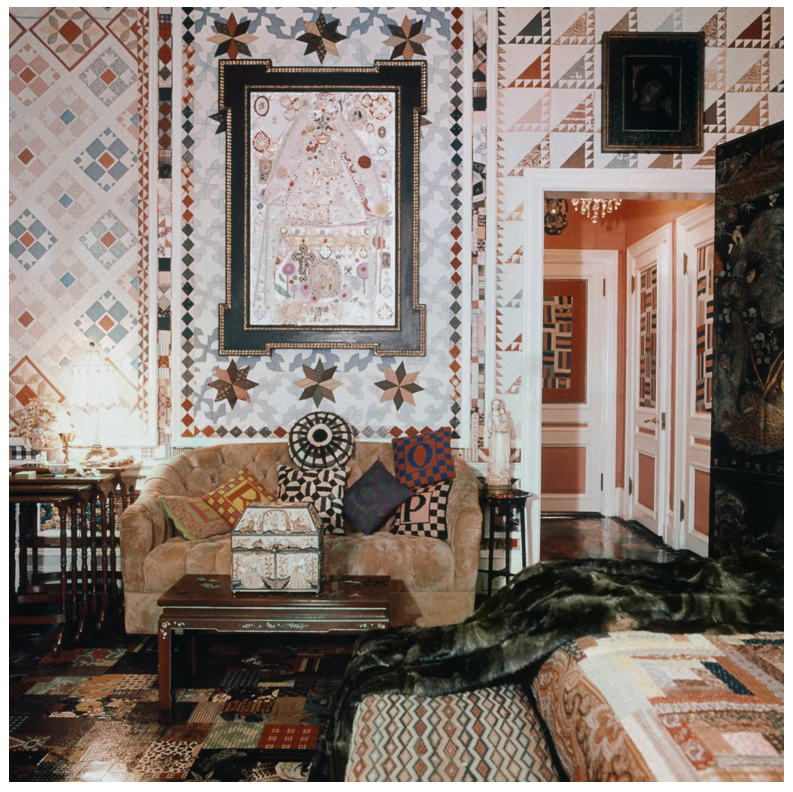Happy New Year: Happy House Warming!
Welcome to BLOCK'S, New Year: New Home, Holiday Housewarming Post! How great is it to arrive somewhere festive, without having to play host, bring anything, or even get out of your pajamas?
A lot is happening. I'm writing a lot. I'm sewing. I'm interviewing amazing people, even traveling! Each part is being squeezed in (if not stolen), as usual, and perhaps not as gracefully as I would always prefer. But what more could I ask for? Between these opportunities, having a wonderful family, and great friends, I'm starting 2017 blessed and grateful.
My resolution for 2017 (verses my fictitious one, involving something to do with giving up cheese), is to continue exploring examples of creative bravery in art making - creating an even more dynamic space about the meaning, making, and metaphors of quilts.
My thanks to all of you who have and continue to encourage me. I appreciate it in ways I hope you see reflected here. Here's wishing you a creative and courageous 2017!
Aimée
- BLOCK'S Top 5 -
Best Insta-Inspiration for 2017!
I've alway enjoyed paying keen attention to all things quilt related on the internets - especially the brave, innovative, and esoteric. But I also find the nets to be a complete time sucker of creativity, when I'm really honest with myself. It's one of the reasons I return regularly to my favorite sources for inspiration. I'm alleviated of any guilt, and get a creative fix.
So, with this in mind and without further adieu, here are my top 5 Instagram feeds to follow in 2017:
#2. "A quilt with coinciding color swatches indicating what plants, minerals, and insects, were used to dye the fabric," posts Maura Grace Ambrose of Folk Fibers. This feed isn't just about quilts. It's about how to create a life. It's about soul.
#5. The International Quilt Study Center and Museum (IQSCM - or, Quilt House, for short) is my pick for best museum to follow. Granted, its Instragram feed isn't nearly as wonderful as its larger website (to say nothing of it's project, World Quilts). But, this way you'll be up to speed on exhibit happenings and behind-the-scene moments.
#1. Completely Cauchy is Chawne Kimber's feed; a venerable feast of precision piecing, snapshots of life, and glimpses into topics informing her groundbreaking art.
Some of you will already be familiar with my top picks - especially the MQG crowd. Take Chawne Kimber, who's compelling identity politics quilts, precision piecework, and thoughtful diaries, have some of us returning to her online spaces (Completely Cauchy & @cauchycomplete) daily. While The Monument Quilt, by Force, a community activist project shining a light on rape culture and sexual assault, may still be understood by many as simply a news story - not as a living/breathing effort seeking on-going engagement. The expanding quilt is designed to, "coincide with legislation, court cases, protests, and other acts of resistance against rape and abuse." Which means, it requires our attention and participation to succeed (#monumentquilt).
Outside of my own way of surfing the web for inspiration, I know I still miss a ton. So I'd LOVE to know your top 5 as well. If you have a gem worth sharing, please do!
patchworkandpixels@protonmail.com
#3. The community activist project known as The Monument Quilt, created by survivors of sexual assault, continues to effect real change and will culminate with a display at the National Mall and along the U.S. /Mexico Border in 2018. It is astonishing just how many social, cultural, political, and economic hurdles this quilt project tackles, simply because it tackles sexual assault. Follow the project on Instagram at #monumentquilt.
Fashion Icon that Primed Gallery Walls for Quilts
- Gloria Vanderbilt & Cooper's Bedroom -
A Few Thoughts on the Art History of Quilts, by Aimée
Above images: Cooper's Room, one of Gloria Vanderbilt's many famously decorated bedrooms. As it appeared in the February edition of Vogue magazine, 1970. Source.
Patchwork pillows from recycled fabrics, with curtains underway. My own take on Cooper's Room. Stay tuned for updates...
In 2010, well-known CNN anchor, Anderson Cooper, penned a lovely tribute in Vogue, about his mother, the fashion designer, decorator, artist, and heiress, Gloria Vanderbilt (GV). In it, he describes his childhood experiences growing up under his mother's profound influence, and specifically recalls the visual impact of one of her many famously designed bedrooms - a room inspired by quilts.
"The one I remember most was a bedroom my mother covered entirely in patchwork quilts: the walls, the ceiling, the furniture, she’d even glued quilts to the floor and had them coated with polyurethane. It was like being inside a collage. I’ve never seen anything like it since."
-Anderson Cooper
Quilt mavens reading this post will, no doubt, find this bedroom impressive in scale, but also thought-provoking. For one thing, GV glued old quilts to the floor and lacquered them. Sacrilege? Inspiring? She was affluent, but a working artist. Does that matter? Worthy questions for another post, I'll admit.
But what's also worth considering is GV's impact on the art history of quilts. Because, at it turns out, Cooper's Bedroom, as it was referred to in Vogue back in Feb. 1970, has a place in it.
GV after all, is the niece of Gertrude Vanderbilt Whitney, founder of the Whitney museum - who had fought for and won custody of GV when she was ten years old, and who was also a significant champion of women artists and folk art. Furthermore, GV herself was (and remains) a famous fashion designer and creative; a huge cultural influencer. Therefore, given that this room was designed and photographed in 1970 and that, "GV's lacquered floor was inspired by one [made of paper] she had seen years earlier in the apartment of Juliana Force, the first director of the Whitney Museum" (referenced from the blog The Peak of Chic, from the book The World of Gloria Vanderbilt, by Wendy Goodman), means that GV was shaping popular cultural opinions about quilts, at the same time the exhibit Abstract Design in American Quilts was in its planning phase.
That exhibit, as many of us well know, was seminal for catapulting popular affection for quilts into the mainstream, and re-contextualizing quilts in proximity to art. But similarly to Cooper's Bedroom, it did little to place quilts in the category of art. Slim context was provided throughout the exhibit. Names, process, narrative, these ideas were excluded entirely from display. Supplanted titles, dimensions, and a date, was what a viewer had to go by. Definitely not art.
And yet, what is becoming increasingly clearer, is just how well primed the pump was (prior to the Whitney exhibit) for the general public to so enthusiastically accept the inherent artistic attributes of quilts on account of popular culture. And for this, GV and other cultural influencers, ones using quilts for a variety of creative reasons at the time, deserve some credit.
Larger thanks, however, will remain on reserve for whomever or whatever sees quilts formally accepted as art writ large, as a reflective medium for expression, as reflective as painting, photography, sculpture, even music.
In the meantime my friends, I (just like you) will go on loving quilts every time I see their influence anywhere. And as far as the recycled denim pillows I just finished are concerned (and the matching curtains in production to boot) I suppose I have the-one-and-only Gloria Vanderbilt to thank, for giving me the courage to go whole-hog.
Footnote: For further context on quilt exhibition practices prior to the exhibit, Abstract Design in American Art, see the International Quilt Study Center's World Quilts: The American Story. I would also like to make reference to Janneken Smucker's book, Amish Quilts: Crafting an American Icon, who remarks on the Whitney's exhibition history and GV's patchwork inspiration for "Cooper's Bedroom."
Happy New Year! And thanks for visiting BLOCK!












